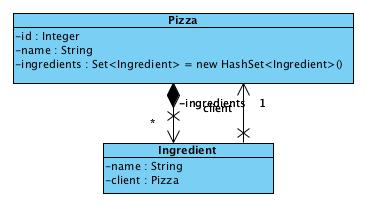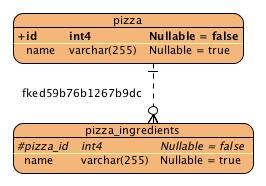Full source code is provided in the package: de.laliluna.component.collection2
| Classes | Tables |
|---|---|
|
|
Annotation mapping.
import java.util.HashSet;
import java.util.Set;
import javax.persistence.*;
....... snip ........
@Entity
public class Pizza {
// ... snip ...
@ElementCollection
@CollectionTable(name="pizza_ingredients", joinColumns =
@JoinColumn(name="pizza_id"))
private Set<Ingredient> ingredients = new HashSet<Ingredient>();
@ElementCollection defines the component mapping. @JoinTable is optional. It specifies the name of the ingredient table and the foreign key column.
Deprecated Hibernate extension
Before Java Persistence 2 only Hibernate supported this kind of mapping. The annotation was named slightly different @CollectionOfElements and is now deprecated.
import org.hibernate.annotations.Parent;
import javax.persistence.Embeddable;
@Embeddable
public class Ingredient {
private String name;
@Parent
private Pizza client;@Parent specifies the property to be a reference back to the embedding class, i.e. PizzaClient in our case.
XML mapping.
<hibernate-mapping package="de.laliluna.component.collection2">
<class name="Pizza" table="tclient" >
<!-- .. snip .. ->
<set name="ingredients" table="pizza_ingredients">
<key column="client_fk"></key>
<composite-element class="de.laliluna.component.collection2.Ingredient" >
<property name="name"/>
</composite-element>
</set>
</class>
</hibernate-mapping>
Samples of use:
/* create and set component */
Pizza pizza = new Pizza("Speciale");
Ingredient cheese = new Ingredient("Cheese");
Ingredient salami = new Ingredient("Salami");
Ingredient tomatoes = new Ingredient("Tomatoes");
pizza.getIngredients().add(salami);
pizza.getIngredients().add(cheese);
pizza.getIngredients().add(tomatoes);
session.save(pizza);
/* select pizza clients having an address in London */
List<PizzaClient> list = session
.createQuery(
"from Pizza c left join c.ingredients a where a.name = :ingr")
.setString("ingr", "Tomato").list();
